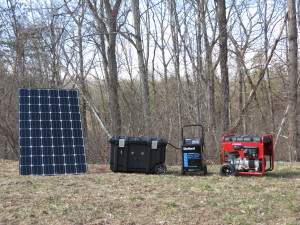Hello!
First of all, thanks for stopping by Grid Ridder. I just wanted to take a moment to tell you a bit about what this site is all about. During hurricane Sandy, our family lost power for 11 days. To be sure, many people had more troubles than just the loss of electricity. If you saw pictures of the Jersey shore and other areas or if you’ve been through a similar disaster, you can probably relate. We were lucky enough to have a gasoline powered generator that we had purchased about 10 years prior. We ran that generator non-stop during the storm until finally, one of the brushes failed. Of course, the generator failed at the start of day 9 – so we were forced to vacate our home and head to “higher ground”. I was annoyed that I had to leave our home and was determined to prepare a little better for the next emergency.
I decided to rethink the idea of a DIY mobile emergency backup power system and then try to design and build something myself that was powerful enough to matter yet, portable enough to take on the road if necessary. I wanted to combine as many different energy sources (like solar, gasoline, propane etc..) in case one became unavailable. I searched online for: “solar generators”, “battery backup power”, “home backup power”, “emergency backup power” and I found the systems out there were way over priced for what you received in terms of energy output and overall endurance. One of the issues is weight – batteries are very heavy – the system I built here weighs over 300lbs! (but, at least it rolls thankfully!) With a little effort, you can build this system for half of the cost of any turnkey system you will find online and get a lot more power for your money.
A few valuable lessons that I learned along the way:
- Before thinking about electricity, think about basic survival needs – specifically your heat or cooling requirements – most of the victims on the Titanic died from hypothermia – not lack of food or water. Try and utilize non-electrical heat if you can – wood, natural gas, propane, oil, etc. You can use a space heater in a pinch but, it will use a lot of battery juice.
- Once you have “protected the core” (temperature & shelter) you can consider everything else. You probably want to preserve the food in your refrigerator, run a sump pump, turn on a few lights, connect to the internet and yes, even watch tv hence, the need for an alternate electricity source or sources.
- Plan out your energy requirements beforehand and with that, your specific activities during the “off grid” days (including card playing!). I’ve included an example of the schedule we use in the Excel spreadsheet in the “System Planning” tab of the main page.
- You may have a great alternate energy source but, if the one dollar part that makes it go doesn’t work, you are out of luck – keep a few extra consumable parts on hand – (in my case the $5 set of electrical brushes!)
- Freedom isn’t free – neither is energy. If the sun doesn’t shine during an emergency (like in a hurricane), a solar powered battery backup system is now a very expensive paperweight. Similarly, if the gas stations are closed because they don’t have electricity to run their pumps, your generator is limited to the gasoline you have on hand. Why not combine them both? If you have natural gas or propane at your house, maybe consider one of the dual or tri fuel generators.
You may notice this system design is sort of a “hybrid” system for backup power that is, it uses a gasoline powered generator, a battery bank with inverter, and solar panels. Here is why I chose this design:
- A generator is great for continuously running many small or a few “big ticket” luxury items when needed. These luxuries may include 240 volt appliances like an oven, central air conditioning, electric dryer etc… it is also great for recharging your battery bank quickly (with a charger of course) if the sun isn’t shining. BUT, to run an average generator around the clock to keep your refrigerator and a few lights running is highly inefficient and very costly.
- A battery bank with an inverter on the other hand, is great for running smaller 120 volt items (yes, you can get 240 volt inverters etc.. but I decided to leave those items for the generator) like your refrigerator, lights, IPhone, network, laptops etc…BUT, it needs to be recharged by some external force like the sun or a generator– if the sun isn’t shining, you are out of luck. This is why I keep the generator in the system loop. I utilize the generator twice a day to charge the batteries, use the “luxury” 240 volt items, and then run silent on batteries for the remainder of time. If the sun is out, I consider that a bonus and will recharge for “free” using the solar panels. This reduces the generator run time even more and thus gasoline consumption and extends your off grid time which is ultimately the main goal.
- I wanted also to create a manageable and portable “bug out” system that would take care of my energy requirements at the house for at least 11 days based on the fuel I store there OR that I could pack up and take with me if needed. (I don’t store large quantities of gas in containers but, I DO count the gas in the vehicles, tractor, and snow blower for example)
Of course, if you want to invest in a major system to run your entire house year round, go for it. This is not that system. There are plenty of web sites out there to get that information from. The tax rebates seem ok but, even so, plan on spending $25K-$75K and remember that those types of systems stay with your house – even when you leave!
And so begins the journey that is “Grid Ridder”! Please feel free to ask questions or leave comments and most of all have fun building your own!
Jim

